
Mozac Abbey is a former Cluniac monastery in the commune of Mozac near Riom in Auvergne, France.

Mozac Abbey is a former Cluniac monastery in the commune of Mozac near Riom in Auvergne, France.

A monastery was founded here in either 533 or 680 by Saint Calminius (Saint Calmin) and his wife, Saint Namadia. Calminius is said to have given the new monastery relics of Saint Peter, to whom the foundation was dedicated, and of Saint Caprasius of Agen, brought from Agen, of which there has long been no trace. From "King Pepin", either Pepin the Short in 764 or Pepin II of Aquitaine in 848, the monastery received the relics of Saint Austremonius, first bishop of Clermont and responsible for the evangelisation of the Auvergne; the abbey passed under royal protection. These have survived until today and are preserved in a painted wooden casket of the sixteenth century. The chasse reliquary of Calminius, or Saint Calmin, is one of the outstanding masterpieces of Limoges enamel.
In 1095 Pope Urban II launched the First Crusade at the Council of Clermont and at the same time affiliated Mozac to the Cluniac Order; nevertheless, Mozac was able to retain some of its independence, as it remained an abbey rather than becoming a dependent priory, as were most of Cluny's affiliated houses.
The abbey was rebuilt in the early twelfth century. The buildings were severely damaged and largely destroyed in a series of earthquakes between 1477 and 1490, and among the few remains of the Romanesque architecture that have survived are carved Romanesque capitals (illustration) that were particularly noted by Prosper Mérimée in the first assessment of medieval monuments in France: "What renders the church of Mozat [sic] particularly interesting are its capitals, which, for the merit of their execution, may be compared to the best of Brioude". [1] The rebuilding was carried out in the Gothic style, using the harder Volvic stone instead of the limestone of the earlier constructions.
From 1516 Mozac was ruled by commendatory abbots who were not in residence. In 1790 the abbey was dissolved in the French Revolution. The abbey church survives as the parish church of Mozac.
Romanesque capitals with figurative carvings of high quality survive in some quantity, and the church still contains some elements of Romanesque architecture.
The relics of Saint Austremonius are still preserved here, as are those of the founder Saint Calminius, in a chasse reliquary shrine (illustrations of details) which is the largest extant reliquary in mediaeval Limoges enamel in the world.


Aurillac is the prefecture of the Cantal department, in the Auvergne-Rhône-Alpes region of France. The inhabitants of the commune are known as Aurillacois or Aurillacoises.

Auvergne is a cultural region in central France.

Cluny Abbey is a former Benedictine monastery in Cluny, Saône-et-Loire, France. It was dedicated to Saint Peter.

Saint-Flour is a commune in the Cantal department in the Auvergne region in south-central France, around 100 km south of Clermont-Ferrand. Its inhabitants are called Sanflorains.
Waiofar, also spelled Waifar, Waifer or Waiffre, was the last independent Duke of Aquitaine from 745 to 768. He peacefully succeeded his father, Hunald I, after the latter entered a monastery. He also inherited the conflict with the rising Carolingian family and its leader, Pepin the Younger, who was king of the Franks after 751 and thus Waiofar's nominal suzerain.

The Abbey of Saint Maurice, Agaunum is a Swiss monastery of canons regular in Saint-Maurice, Canton of Valais, which dates from the 6th century. It is situated against a cliff in a section of the road between Geneva and the Simplon Pass. The abbey itself is a territorial abbacy and not part of any diocese. It is best known for its connection to the martyrdom of the Theban Legion, its original practice of perpetual psalmody, and a collection of art and antiquity.

Clermont-Ferrand Cathedral, or the Cathedral of Our Lady of the Assumption of Clermont-Ferrand, is a Gothic cathedral and French national monument located in the town of Clermont-Ferrand in the Auvergne. It is the seat of the Archbishops of Clermont.
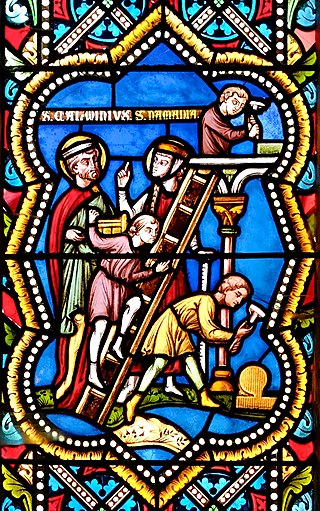
Calminius, also known as Calmin, founded three French abbeys in the 6th or 7th centuries AD: Mozac Abbey, in Puy-de-Dôme; Laguenne Abbey and the abbey of Monastier-Saint-Chaffre. His Saint's day is August 19.

The Roman Catholic Archdiocese of Clermont is an archdiocese of the Latin Church of the Roman Catholic Church in France. The diocese comprises the department of Puy-de-Dôme, in the Region of Auvergne. The Archbishop's seat is Clermont-Ferrand Cathedral. Throughout its history Clermont was the senior suffragan of the Archdiocese of Bourges. It became a metropolitan see itself, however, in 2002. The current archbishop is François Kalist.

The Basilica of Notre-Dame du Port is a Romanesque basilica, formerly a collegiate church, in the Port quarter of Clermont-Ferrand, between Place Delille and the cathedral. From the 10th century to the French Revolution it was served by a community of canons, regular until the 13th century, and thereafter secular.
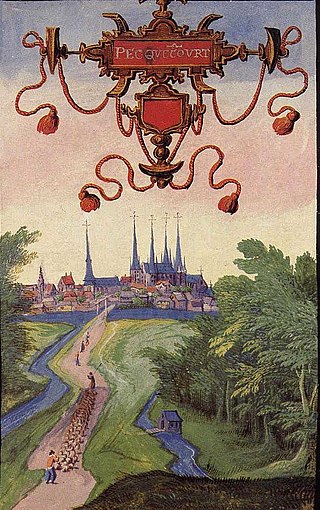
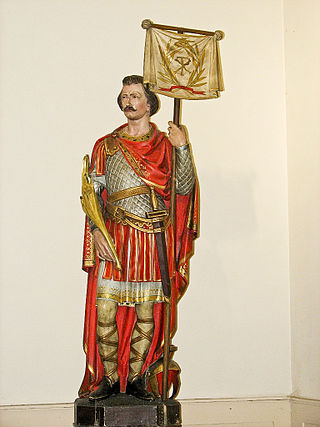
Saint Julian of Brioude (†304) was a legendary martyr and saint from the Auvergne region of France. Although the main focus of his cultus was in the small village of Brioude, he was originally from the city of Vienne, and also associated with Clermont. He was most famous through his association with an aristocratic family of bishops of the time, his most notable proponents being St. Gallus of Clermont and St. Gregory of Tours. Gregory wrote a vita of Julian, but his attempts to expand the saint's cult from the Auvergne to Touraine and Aquitaine were unsuccessful, and Julian is now only remembered through his basilica in the town of Brioude itself.

Namadia was the wife of Calminius. On her husband's death in the 6th or 7th century she retired to end her days in the monastic community at Marsat, which later became a dependent house of Mozac Abbey 2 kilometres away.

Moissac Abbey was a Benedictine and Cluniac monastery in Moissac, Tarn-et-Garonne in south-western France. A number of its medieval buildings survive including the abbey church, which has a famous and important Romanesque sculpture around the entrance.

Yves Morvan is a French archaeologist, specialist of the romanesque art and of the iconography of Blaise Pascal. He is also a restorer, sculptor of religious characters, as well as member of the Academy of Science, Literature and Arts of Clermont-Ferrand.
The following is a timeline of the history of the city of Clermont-Ferrand, France.
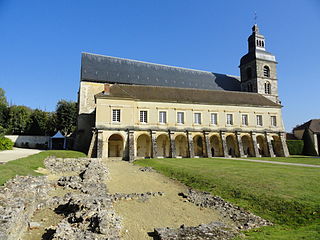
Hautvillers Abbey, or more formally the Abbey of St Peter, Hautvillers, is a former Benedictine monastery in the Hautvillers commune of the Marne department in north-eastern France. The abbey remained active between 665 and the French Revolution of 1789. It housed the relics of Saint Helena, Empress and mother of Constantine, between 841 and 1819. One of its monks, Dom Pérignon, contributed to the development of sparkling wine in the Champagne region. The building has been classified as a monument of historical value since 1983.
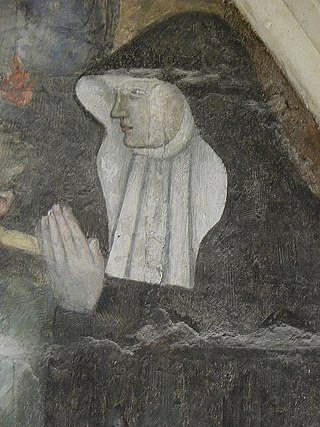
Saint-Pierre-les-Dames was a convent of Benedictine nuns established in the city of Reims for over a thousand years, from the early Middle Ages to the time of the French Revolution. The monastery was certainly in existence by the reign of Charlemagne, and according to some sources dated from as early as the 6th century, although it has been argued that the earlier date could be due to confusion with a different and shorter-lived monastery in the city, also dedicated to St Peter.